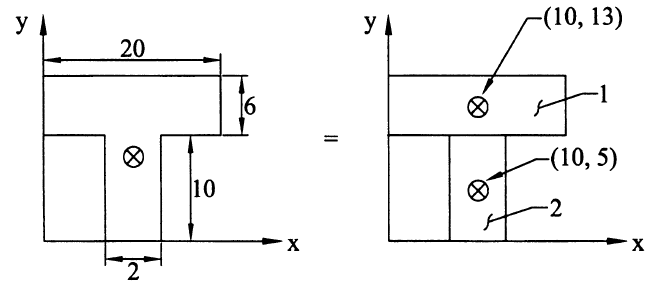Find the centroid, relative to x and y, for the cross section shown in Fig. 3.25.
Question A3.3: Find the centroid, relative to x and y, for the cross sectio...

The Blue Check Mark means that this solution has been answered and checked by an expert. This guarantees that the final answer is accurate.
Learn more on how we answer questions.
Learn more on how we answer questions.
It is easiest to formulate these solutions in tabular form. Hence, note that
| \overline{y}_{i}A_{i} | \overline{x}_{i}A_{i} | Area | |
| 13(120) | 10(120) | 20(6)=120 | Part 1 |
| 5(20) | 10(20) | 2(10)=20 | Part 2 |
Therefore,FIGURE 3.25 Compute the first moment of area of this composite section.
\overline{x}=\frac{\sum{\overline{x}_{i}A_{i} } }{\sum{A_{i}} }=\frac{10(120)+10(20)}{120+20}=10,\overline{y}=\frac{\sum{\overline{y}_{i}A_{i} } }{\sum{A_{i}} }=\frac{13(120)+5(20)}{120+20}=11.86
Note, too, that we could obtain the same result by computing values for a rectangular area 20\times 16 and then subtracting out small rectangular areas to yield the T-shape, namely
| \overline{y}_{i}A_{i} | \overline{x}_{i}A_{i} | Area | |
| 8(320) | 10(320) | 20(16)=320 | Part 1 |
| 5(90) | 4.5(90) | 9(10)=90 | Part 2 |
| 5(90) | 15.5(90) | 9(10)=90 | Part 3 |
whereby
\overline{x}=\frac{\sum{\overline{x}_{i}A_{i} } }{\sum{A_{i}} }=\frac{10(320)-4.5(90)-15.5(90)}{320-90-90}=10,\overline{y}=\frac{\sum{\overline{y}_{i}A_{i} } }{\sum{A_{i}} }=\frac{8(320)-5(90)-5(90)}{320-90-90}=11.86.
which is the same as found above.
Related Answered Questions
From the above results [Eqs. (3.49) and (3.41)], t...
Given P=120 mmHg\cong 16,000N/m^{2},[/latex...
Knowing that x^{2}+y^{2}=a^{2}, or...
Although there are multiple ways to perform the re...